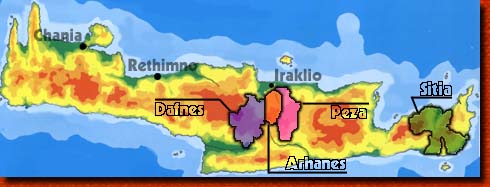
While the French can’t wait to impress you with their cooking, and the Italians want to romance you with theirs, the Cretans have kept their cuisine- the real stuff that is, pretty much a secret. And the fact of the matter is— that this culinary cradle of the Mediterranean can legitimately boast one of the most exciting AND healthful cuisines in the world. In actual fact, the modern reference to healthy eating known as the „Mediterranean Diet” is based on the Cretan Diet.
After the second World War, it was discovered that the so-called „starving” Cretans were considerably healthier than Americans, who did not suffer from any great scarcity of food. The islanders had existed very well on the over 150 varieties of wild greens dotting the mountainsides cooked in abundant amounts of extra virgin olive oil and liberally doused with fresh lemons, bread or rusks, snails, honey, goat or sheep’s cheese, sometimes fish, virtually no red meat and several glasses of wine or raki (similar to Grappa) daily. Even today, menus rely on the proximity of these local ingredients (many organic) all combined in imaginative ways to generate unique flavors and varied dishes. Simple and fresh is the key to a mouth-watering end result—an opinion shared by many of the chefs making their mark in Crete. Their innovations are born of their Grandmother’s kitchens and inspired by the acceptance of a broader Mediterranean cuisine.
Someone once said that Cretans are such a hospitable people because they have been invaded so much. Perhaps there is a note of truth to that wry comment, since Crete’s turbulent history includes being ruled by Byzantium, Venice and the Ottomans. This panoply of invaders who have at various times inhabited Crete, have bequeathed a rich legacy in architecture, helped shape the cultural landscape and last but definitely not least, had an inspiring effect on the island’s culinary heritage. While typical Cretan fare is often very simple, with appetizers and dishes like rusks with tomato & cheese, wild greens and cheese pies, it can also be more lavish like rabbit casserole cooked with red wine, cloves, cinnamon and cumin- harkening back to the Ottoman era or lamb slow-baked with wild artichokes with an avgolemono sauce.
From a gastronomic point of view, Crete has been practising „Cuisine de Terroir” (Food of the Earth) long before it came into vogue, became a blog topic or even before anyone had actually put a name to it. The concept of „terroir”, referring to the unique flavors imparted to food and drink by a region’s specific climate, soil weather and growing conditions, has been widely used by wineries since time immemorial, but in the world of gastronomy it is a recently coined phenomenon. So much of the food in Crete has such a strong sense of place, making for a much more sensual tasting encounter. Each time you eat a salad knowing that the wild greens come from the mountain you are looking at or eat some cheese made from the milk of sheep who have grazed on local herbs, you are experiencing a panache refining of robust country flavors—fresh, locally-sourced seasonal ingredients.
While olive oil, whole grains, snails and wild greens are part of the island’s culinary history, it is the island’s WINE which completes the composition of the Cretan Diet. Cretans first produced wine during the Minoan period . In those times, grape varieties were limited, but today, in addition to the world cultivars, even the most obscure varieties are making a comeback at the hands of a new generation of pioneering winemakers who are not just copying Old World templates, but are rather looking at their native grape varieties best suited to a particular terroir to come up with a new array of fascinating blends of local varieties and often partnering with world cultivars.
Always celebrated as a tourist destination for beaches and antiquities, Crete, is fast becoming a foodie hotspot, which could rival many of the European capitals in the gourmet game and now dining on the Mediterranean’s 5th largest island delightfully blurs the lines between tradition and innovation, between upscale and homey without sacrificing a whit of creativity or devotion to the highest quality local ingredients. It is an island that can boast a colorful and sophisticated food culture, where a new generation of young, maverick chefs and winemakers are giving ancient foods and grapes a 21st-century make-over.









